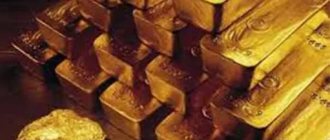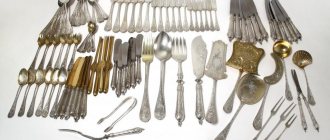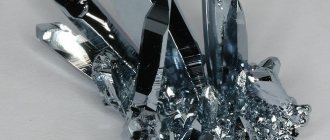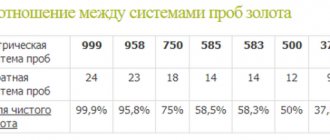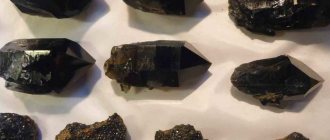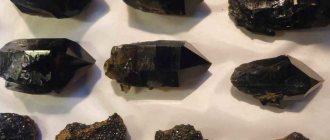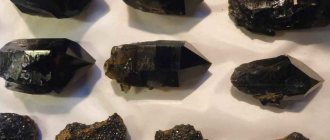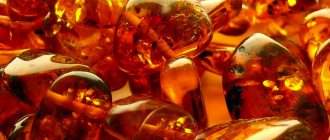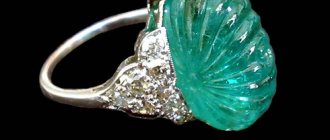Art Nouveau - the paradox of jewelry
At the end of the 19th century, a new style arose in the jewelry world - “Modern”, which immediately conquered the world, striking everyone with its brightness, imagery and decorativeness. This style is characterized by a combination of symbolism and drama; the main motifs are mythological characters, only in the variation in which jewelers see them. A woman who shines in Art Nouveau jewelry is a bright, sophisticated, luxurious and fatal woman, who is called Femme Fatale.
“Modern”, without a doubt, celebrates the symbolism of the passing century, the new role of women in society, as well as the changes that have occurred over the last century. The end of the 19th century is considered a very difficult period in history, which could not but be reflected in the jewelry society. Europe is plagued by turmoil, both economic and political, and at the turn of the century the new movement “Modern” was born.
Just as England can be considered the birthplace of the Art Deco style, France and Russia can be considered the birthplace of the new “Modern” style. This style flourished simultaneously in the two countries listed above, but in Russia, along with the new style, a characteristic national style continues to develop. French jewelers began to look for inspiration not in their native culture, but in the countries of the East, and above all, Japan. The result was a combination of several cultures at once, which is why “Modern” is called the paradox of jewelry.
Among the Russian names, it is necessary to mention Sazikov, Ovchinnikov and Khlebnikov, because it was Russian jewelers who declared themselves loudly, shocking the whole world with jewelry. In 1851, at the London Exhibition, Ignatius Sazikov presented a stunning silver product that combined elements of Art Nouveau and original Russian subjects. After this exhibition, Sazikov’s company began to receive orders from all over the world.
In the jewelry world, Russia began to be taken not just seriously, the country was called the spiritual center of a new direction. However, it is not right to give all the laurels of the “Modern” period only to Russia; France was a successful competitor to our country. The “Modernist” era has been described as the “beautiful era of the bourgeoisie,” where jewelry was a symbol of wealth, prosperity and prosperity.
It is believed that the main source of the Art Nouveau style was a passion for botany; between 1896 and 1900, Eugene Grasset published a number of his works entitled “The Plant and its Use for Ornaments.” Japanese art became another direction of the Art Nouveau style; in 1878, at the International Paris Exhibition, Japanese graphics captivated jewelers, giving rise to a new direction within Art Nouveau. French jewelers and designers actively used Japanese ideas, but the result was a truly French creation.
French historian and jeweler Henri Wever considered the Japanese influence on French jewelers to be so significant that he devoted several pages to it in his book French Jewelry of the 19th Century. One can spend a long time comparing the Russian and French styles of thinking of the Modern era, but there is one undeniable difference: the French turned their attention to Japan and combined the two cultures. Russian master jewelers created a separate branch of the “Modern” style - a national branch that still conquers the world with its originality.
Despite the fact that the Art Nouveau style is associated primarily with luxury and evening wear, jewelry of the late 19th century ceased to be the privilege of only the wealthy class. Jewelers began to create not just clichés, subject to the whims of rich people, but to create true masterpieces that had individuality and taste. Smooth, fluid, asymmetrical forms, refined outlines, and a mystical flavor were evident in Modern jewelry.
If at first floral themes became the main motif of “Modern”, then later mythical motifs, female silhouettes, and natural motifs, such as sea waves, began to be used. The female image became widespread, but not just silhouettes were used, but certain parts of the body: a woman’s swan neck, a chiseled leg, an ideal face...
In conclusion, let's look at the main characteristics of the style. Idea : Russian national color and Japanese culture. Material : any. Motifs : floral, mythical, female image. Shape : smooth lines, asymmetry, sophistication.
Elvira Sviridova
Lucien Gaillard
[/box]
Art Nouveau (Art Nouveau - new art, French) embraced many types of creativity, but in architecture and decorative arts it confidently took the lead. In Germany it was called “Jugendstil” (Jugend - youth, German); in Russia - “modern” (from the French moderne - newest, modern). Art Nouveau jewelry has “geographical” features. French Art Nouveau jewelers, for example, Lucien Gaillard, Georges Fouquet, are masterfully asymmetrical, while the “German mind” (Wilhelm Lucas von Cranach) gravitates towards symmetry. The palette is also different - in Russia it is, perhaps, different than in Europe. So currents can probably be determined geographically.
Formation and features of the Art Nouveau style
At first, Art Nouveau “fed” Gothic (the predominance of vertical compositions, a frequent motif of the lily as a sign of detached sophistication; the image of a thin-armed melancholic maiden, often with closed eyes).
Art Nouveau was also influenced by the Cretan-Mycenaean and Etruscan ancient cultures , and the small plastic arts of Ancient Egypt . The ornamental series borrowed elements from Celtic things (yes, Celtic “braids” are not only tattoos) and handwritten book patterns.
But having rejected copying, modernity carried out a synthesis, deeply comprehending the previous experience of beauty. Compare the Celtic corner design and some brooches of the jeweler Wilhelm Lucas von Cranach . These are clearly not alien images.
Penetration of Japanese “natural” style into European Art Nouveau
Just then, the Land of the Rising Sun finally reached Europe (shoutout to the Japanese artists Hokusai , Hiroshiga , and not only them), and this unexpectedly influenced the new artistic style of Europe. It’s as if a certain filter is hidden inside the Japanese artist. Reality, passing through the narrow sieve of Japanese eyes, appears as an exquisite dance - peaks in the snow and mysterious animals.
This is now Fuji, chrysanthemum, carp and crane for a European - a common artistic place. Japanese. But there was a time when the rose of Europe first gave way to the chrysanthemum - on the artist’s chest (let’s dream: in the buttonhole of his tailcoat!). Waves, streams of rain, foliage and stems of bamboo, the color of sakura, the bends of algae and schools of fish - all this was also included in the system of Art Nouveau ornaments.
Art Nouveau style - manifestation in fashion and jewelry
The female silhouette of a typical representative of the Art Nouveau era snaked, reminiscent of the Latin S. Art Nouveau evening dresses became unusually impressive - due to asymmetry and mannered curved lines. Of the jewelry in the Art Nouveau era, necklaces are especially popular - necklaces with “fringe” (pearl or diamond), ideal for a wedge-shaped neckline. Wide “collars” strewn with stones came into fashion graceful hoops with a stone placed down on a long shaft. Hair was decorated with exquisite combs with gold and stones.
Jewelry art was a “beacon” of the new style. Of course, you can’t do without architectural modernism, but, as a rule, a brooch is created faster than a mansion.
Examples of antique jewelry from the Art Nouveau period: flowers, fairies, curved lines and gems.
The universe of floral (floral in French - floral) Art Nouveau - emerald lizards and snakes, motley-winged dragonflies and butterflies, sunflowers, reeds, irises and orchids...
[/box]
Emancipation allowed the naked fairies of Lalique to multiply and inhabit jewelry. The master inspired a “golden dream” - perhaps not for all of humanity, but for an individual (rich) person. Languid female heads and figures with long hair and flexible arms in “flying” sleeves - perhaps they are the ancestors of all Disney princesses. The smooth fluidity of asymmetrical forms, the subtle construction of the composition, the combination of glossy enamels and green, lilac, blue, white, red stones - a worthy frame for a miniature lady made of gold.
And in the jewelry of real women made of flesh there are a lot of stones (pearls, opals, rubies, demantoids, amethysts, chrysoprase, mother-of-pearl). Not expensive, but decoratively and coloristically suitable gems were selected.
Rene Lalique
Art Nouveau Jewelry Artists
The pressure of high jewelry has finally broken through the wall of academic snobbery. The Society of French Artists opened an applied arts section. Personal exhibitions of jewelry artists began , catalogs began to be published in magazines, and museums began to purchase collections. The World Exhibition, held in Paris in 1900, gave the Maestro-Jeweler a standing ovation.
Rene Lalique. Among the “fathers” of Art Nouveau, one cannot fail to mention Rene Jules Lalique (as, of course, Alphonse Maria Mucha, Georges Fouquet, Charles Robert Ashby and many other masters). In just over twenty years of the Art Nouveau period, René Lalique greatly changed the foundations of the jewelry world. He introduced the motif of a naked female figure. Lalique wonderfully combined horn, mother-of-pearl, glass, and ivory with enamel and pearls, precious and ornamental stones. The king of French glass, he developed a method of injection molding (the incomparable Lalique vases). After working in the houses of Cartier and Boucheron, he opened his own jewelry workshop. Designing jewelry for Sarah Bernhardt added to the maestro's fame.
Wilhelm Lucas von Cranach
Lucien Gaillard. (Lucien Gaillard) was also one of the most prominent jewelers of his time. His original products were more laconic, more “natural” than those of his contemporaries, and were widely known.
Georges Fouquet
[/box]
Charles Robert Ashby
One of the representatives of modern jewelry in London was Charles Robert Ashby . His work, especially the cutlery, simply immerses you in the atmosphere of Tolkien’s film epic (elven line).
Carl Faberge
Carl Faberge. In Russia before 1917, famous artists also worked who made jewelry in the Art Nouveau style. Among them was the famous Carl Faberge.
Art Nouveau: a short but bright life
Archibald Knox
Since the beginning of the 20th century, floral modernism has been on the decline. Manifestations of this style can be found before 1914, but the form is no longer so sophisticated; smooth lines have been replaced by geometric decor. The floral flow of Art Nouveau gave way to the geometric one. Late Art Nouveau already has features of constructivism and a new style with an interesting jewelry embodiment - Art Deco.
Source – JEWELIRUM
Tweet
Art Nouveau jewelry. Pages of history
In the second half of the 19th century, the opening of trade routes with the East in 1858 had a noticeable impact on the development of decorative and applied arts in Europe. Representatives of Japan were invited to participate in the 1862 International Exhibition in London. Ukiyo-e prints, with their original and elegant interpretation of nature, became one of the important components of the new cultural aesthetics. Along with architecture, painting and furniture making, it was reflected in the production of jewelry, where the sophistication of shapes, the intensity of colors and the use of various stones, metals and enamels created a new decorative style.
Representatives of the Arts and Crafts movement in England, led by William Morris, advocated the inclusion of handmade artistic objects in everyday goods. This led to the creation in Europe and the United States of America of industrial training associations that trained specialists in the production of artistic products, similar to the medieval professional guilds.
Pendant “Cornflowers”. Rene Lalique. 1898 Gold, enamel, white chalcedony, pearls.
The exhibition salon of contemporary art by Samuel Bing, as well as the international exhibition of 1895, brought together a large number of artists working in the new artistic style, which was called Art Nouveau in France and Belgium. The opening of an art salon made it possible to present almost all types of decorative and applied arts products. Among them were: products using the stained glass technique of Tiffany, objects of art glass by Emile Galle, jewelry by René Lalique, etc. The development of a new artistic direction was supported by the National Council of Fine Arts in France.
Having created the basis for the development of a new artistic endeavor, Bing initiated the organization of the French pavilion at the 1900 international exhibition in Paris. He personally supervised the design work, attracting talented artists and decorators (E. Colonna, E. Gaillard, etc.).
Pendant “Nymph with butterfly wings”. Rene Lalique. 1897 Gold, enamel, diamonds.
The main artistic means of Art Nouveau was the use of graphic expressiveness of line. She was able to express the effect of movement conveyed in the stylized forms of plants, flowing women's hair, the shape of the human body, animal figures, insects, butterflies, etc. However, the linear forms themselves manifested themselves differently in different countries. Thus, in England, elements of Celtic patterns in combination with the geometric shapes of a square, triangle and knot became widespread. In France, graphic elements of Art Nouveau often reflected the stylized shapes of women's hair and plants. In a number of other countries abstract forms were used, etc.
The ideas and forms of Art Nouveau found their original embodiment in jewelry. Among the products produced, stylized images of dragonflies, butterflies and various fairy-tale creatures have become widespread. From a technological point of view, cloisonne enamel was increasingly used, with the help of which it was possible to “revive” color and light transitions on the wings of butterflies, etc. The rigid forms of the Victorian era were replaced by exquisite images of peacocks (with magnificent plumage), swans, swallows, etc. The world of night, superstition and fear was represented by bats, owls, kites, grotesques and mythological creatures.
Unlike previous times, female figures and faces were often depicted, which organically fit into the natural environment. Sometimes, mythological figures of naiads, nymphs, mermaids, etc. were created. Similar figures were used in the manufacture of tiaras, brooches, bracelets and rings. To a certain extent, we can say that the “cult of female beauty” ruled the world of design at that time.
Jewelry designers were not only creative when working with new materials. Traditional techniques and materials also became objects of artistic experimentation. Gold and silver were used to create the effect of plasticity of form, also contributing to the effect of revitalizing the perception of matter. Precious materials such as opal and moonstone have become widespread, creating mysterious shimmering effects. Ivory was often used for carved wave-like shapes.
The use of the cloisonne enamel technique made it possible to obtain unusual light effects: translucency of insect wings, mixing the colors of various materials with each other and the background, adding the effect of spatial depth, etc. Also, various artistic experiments were carried out with painted and polished glass.
Diadem. Henri Vevey. 1895 Yellow gold, diamonds, translucid technique.
One of the most famous French designers who worked in the Art Nouveau style was René Lalique (1860 - 1945). Being a jeweler, Lalique also worked in other fields of decorative and applied arts. He was amazed by the artistic possibilities of enamel and glass. Among the master’s common subjects were decorative items with a naked female figure. Other famous masters of the new style were Henri Vevey (1854 - 1942) and Eugene Grasset (1841 - 1917).
Comb “Swans and water lilies”. Eugene Grasset. 1900 Bone, gold, embossed, cloisonné enamel.
Veve often used pearls in the organic forms of his pieces. At the same time, products from the Fouquet company, made using a similar technique, became famous. The flourishing of her work was associated with the activities of Georges Alphonse Fouquet (1862 - 1957), a representative of the second generation of the dynasty. To produce jewelry, Fouquet used opals, enamel, gold coinage and colored gemstones. Collaboration with such Art Nouveau masters as Alphonse Mucha and Etienne Tourette only increased the prestige and success of the company.
Necklace “Thistle”. Lucien Gaillard. 1903 Gold, enamel, opals.
One of the famous jewelers who worked in Paris was Lucien Gaillard (1861 - 1933), who specialized in making pendants and pendants. The style of his work was significantly influenced by Japanese art. Gaillard used opal, colored stones and enamel in his products. One of the reasons for the high level of jewelry in France was the professional specialization of the craftsmen. Thus, enamellers often worked independently, providing, if necessary, assistance in the work of jewelers. Even large jewelry houses periodically engaged enamellers in one-time work on a contractual basis.
During the Art Nouveau period, the production of small medals became widespread. They were made on themes of antiquity (Greek and Roman gods and goddesses), depicting a female profile, religious subjects and natural motifs. Such jewelry miniatures were easy to produce and therefore accessible. Sometimes they were made in the form of brooches, pendants, buttons, cufflinks, etc. The production of small jewelry has reached such quantities that they can still be found today.
The popularity of Art Nouveau jewelry came to an end around the time of the First World War. Since then, designers have not returned to its aesthetic, but some elements of the style were reused after 1930.
Art Nouveau is the style of life itself.
For a long time, only the rich and noble segments of the population could afford to purchase jewelry, but the 19th century made many precious items more accessible to other segments of the population. Technological progress has made it possible to develop techniques that create jewelry that is cheaper, but also of lower quality. It would seem that the appearance of inexpensive jewelry and cheap, low-grade gold in conditions of a shortage of jewelry should only benefit jewelers, however, oddly enough, many jewelry brands began to go bankrupt.
It turned out that people did not appreciate the opportunity to buy low-quality and ugly jewelry, even if it was cheap. Many did not see the point in spending money and not enjoying the purchase. A kind of jewelry crisis contributed to the creation of a new trend in the jewelry world, without the chic of historical styles, but at the same time, elegant, stylish and beautiful things came out of the hands of master jewelers. The new style was called Art Nouveau, and became a challenge to the established traditions and rules of the jewelry fashion game.
In almost every country in the world, the Art Nouveau style was born at the same time, only it received different names: in Germany - “Jugendstil”, in Italy - “Liberty style”, in Austria - “Sesission style”, in Spain - “modernism” , and in Russia - “Modern”. This style had exactly the opposite relationship to the jewelry material used. Previously, it was understood that only the best was taken for precious products: gold of the highest standard, precious stones of the first category: diamonds, emeralds, rubies and sapphires, and pearls were also often used.
The Art Nouveau style completely “exploded” the jewelry world: jewelry ceased to have status, but at the same time it turned out to be more individual, allowed to express taste and design ideas, and became more sophisticated and sensual. Jewelers appreciated the charms of other materials; the formalism of diamonds was replaced by the bright colors of opals, tourmaline, chalcedony, moonstone, aquamarine, and green garnets. Diamonds began to be used only as a backdrop, as a wrapper for the concept of the beauty of other stones.
Enamel became the favorite technique of the new style, for which new possibilities were invented and old traditions were revived. The basis of the Art Nouveau style was not the cost of jewelry, but artistic taste. The dawn of this style came at the same time as the dawn in other areas of art: literature, painting, theater. At this time, such masters as Vasnetsov, Vrubel appeared, and the “Silver Age” of Russian literature began. Therefore, it is not surprising that nowadays jewelry in the Art Nouveau style is sometimes valued much more expensive than the Empire style.
If you pay attention to the motives of the Art Nouveau style, then jewelers undoubtedly became more frank: the main direction was the female body, the smooth lines of which symbolized excitement, desire and provocation. The appearance of the female body in jewelry became the most significant innovation of this style. Until this time, female motifs were found only in cameos and intaglios. Jewelers of past centuries held for a long time that a woman simply would not want to wear jewelry that would depict another, sensual, seductive and desirable beauty. However, the success of the Art Nouveau style completely refuted these fears.
Another theme of this style was floral and animal motifs: flowers, snakes, animals, insects, nature. Previously, similar motifs were also used, but in the Art Nouveau style they received a new scope: full, free, detailed creations, a real symbol of life, sexuality and eternity. The same plants were depicted not only as blossoming flowers, but also as buds, rudiments, fading inflorescences: this is precisely life, which jewelers of the 19th century finally recognized.
The most famous name in the Art Nouveau style is the name of Rene Lalique, a jeweler whose work was sold by such famous brands as Boucheron and Cartier. His collection created a sensation in 1895 at the exhibition of the French Art Society; guests of the event were shocked by the grace and frankness of the naturalistic style of jewelry. Smooth female forms, gentle curves of butterflies, flexible grace of flowers and plants - all this most accurately reflects the direction of the Art Nouveau style.
As a summary, let’s draw a line under the main characteristics of the style. The idea: not the cost of the decoration, but its artistic value. Material : semi-precious stones are valued on a par with crystals of the first category. The motifs are naturalistic themes. Shape : elongated lines, smooth curves.


